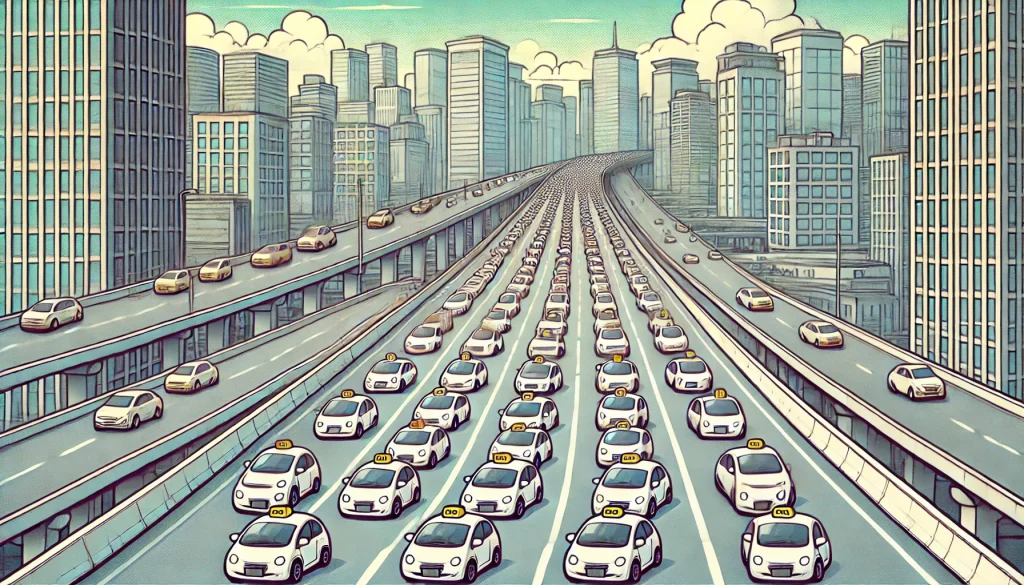Contents
Introduction:
As Tesla China’s Robotaxi is set to officially launch on August 8, 2024, Baidu’s Apollo is also rapidly expanding its services. Meanwhile, other domestic autonomous driving companies such as AutoX.ai, Pony.ai and Saicmotor have already obtained commercial licenses in Shanghai, allowing them to offer driverless taxi services soon in parts of Pudong New Area. These events mark the beginning of a new, hidden commercial war, one that is not only a competition of technology but also a battle for market share. The rapid development of autonomous driving technology has undoubtedly brought significant changes to the transportation industry.
Firstly, passengers using Baidu’s Apollo have posted various videos on Douyin, praising the low prices and good performance of driverless taxis in Wuhan. However, this transformation has also sparked widespread social concern and anxiety. Taxi drivers in Wuhan have already started protesting, pointing out that driverless taxis are taking away their livelihoods and posing a threat to social stability. This grassroots protest differs from past isolated resistances; it represents a broad and united voice of traditional drivers, highlighting the immense pressure on the traditional taxi industry.
Against this backdrop, companies like Baidu ‘s Apollo, AutoX, Pony.ai, Saicmotor and Tesla are vying to take the lead in this emerging field. The application of autonomous driving technology is not just a display of technological advancement but a profound challenge to existing business models and social structures. At this critical moment, how do we face the reality of “China’s Robotaxi replacing traditional taxi drivers”? The Chinese government and society need to carefully consider the promotion strategies of autonomous driving technology, ensuring that while showcasing technological achievements, we also protect existing job opportunities and social stability.
What Does It Mean for China’s Robotaxi to Replace Traditional Drivers
Apollo auto is a self-driving taxi service launched by Baidu, with the Chinese name “萝卜” ( Pinyin: Luóbo) being a playful take on “robot.” This name is both whimsical and tech-savvy. After six years of development, this service is now operating in cities like Wuhan at very low prices, attracting global attention. This pricing strategy reminds me of the early days of shared bicycles, such as Mobike, which also started with very low prices to quickly capture the market.
The core of this business model is to rapidly accumulate users and market share through low pricing strategies and then realize profits through other means, such as raising prices or through advertising. Similarly, Didi Chuxing used a similar approach, initially attracting a large number of users with low prices and then gradually increasing prices to achieve profitability.
For ordinary consumers, this model brings short-term economic benefits, but it is important to be wary that in the long run, the price and quality of services may change. Once the market is monopolized by a few large investors, consumer choice may diminish, and prices may no longer be as friendly.
From the perspective of society and the market, this aggressive market expansion strategy may impact the healthy development of the market. When a field is monopolized by a few large companies, the survival space for small and medium-sized enterprises is squeezed, reducing market diversity and competitiveness, or even eliminating it.
Finally, from the perspective of investment institutions, this is an efficient market expansion strategy. They quickly build market advantages through substantial capital investment and then seek profit points. However, this model often overlooks long-term sustainability, especially after price increases, when user experience may suffer. This strategy may be successful in the capital market, but it may not be the best choice for the actual market and users. Overemphasizing market expansion while neglecting service quality and user experience may ultimately lead to user loss and negative brand impact. While this business model may seem beneficial in the short term, in the long run, it may negatively impact market health and consumer rights. Investment institutions pursue quick returns and market share, but as consumers, we need to view these emerging services more rationally, not just focusing on immediate benefits while ignoring potential future risks and costs.
Risks of Robotaxi and Traditional Taxi Drivers in China
The large-scale deployment of services like Baidu’s Apollo and the popularization of driverless taxis bring numerous social, economic, and technical impacts and challenges. Firstly, the extensive deployment of driverless taxis indeed significantly impacts the livelihoods of traditional taxi and ride-hailing drivers. While this is a trend driven by technological advancement and the capital market, for drivers who depend on this industry for their livelihood, it undoubtedly represents a major crisis. Although autonomous driving technology can improve operational efficiency and reduce labor costs, its contribution to social development may not be as significant as imagined. Especially in urban traffic, the number of cars will not decrease due to the introduction of autonomous driving technology, and traffic pressure and environmental issues will not be fundamentally resolved.
Secondly, from a technical perspective, “LiDAR” and “Vision-Based” autonomous driving technologies are applications of existing technologies rather than entirely new technological innovations. While they have great application prospects in certain specific scenarios, such as hazardous driving environments, industrial settings, or ordinary private cars, they are not essential in urban taxi and ride-hailing industries. Moreover, if these technologies are promoted on a large scale before they are fully mature, it will increase the risk of traffic accidents, posing a major safety concern for society.
Moreover, the differences between the Second Industrial Revolution and the current Fourth Industrial Revolution are indeed significant. While technological progress during the Second Industrial Revolution led to the disappearance of some traditional jobs, it also created a large number of new employment opportunities. However, in the current Fourth Industrial Revolution, the development of artificial intelligence and robotics technology has indeed brought more complex challenges. Especially in a populous country like China, with a population of 1.4 billion, the number of drivers engaged in the taxi industry is enormous, and their livelihoods are directly affected. According to a report by Cyanhill Capital, the number of registered ride-hailing drivers exceeds 100 million, with about 7 million drivers active daily. Such a large group will face enormous employment pressure if replaced by autonomous driving technology.
These drivers are not only working to support their families but also carrying the hopes and futures of their entire families. Losing this job will have a huge impact on their family lives, children’s education, and elderly care. In this situation, society needs to consider how to provide new employment opportunities and training for these people, allowing them to find their place in the new economic environment.
How to Address Robotaxi in China
Facing the rapid development of autonomous driving technology, we must carefully consider its promotion strategies. Only through steady advancement and reasonable regulation can we showcase technological achievements while protecting existing job opportunities and social stability.
- Restrict the application of autonomous driving technology in specific fields: For industries such as taxis and ride-hailing that provide a large number of jobs, comprehensive promotion of autonomous driving technology should be considered with caution. At this stage, autonomous driving technology can be limited to specific fields or scenarios, such as logistics transportation and internal transportation in industrial parks, to demonstrate technological progress while protecting existing jobs.
- Phased pilot programs: Conduct small-scale pilot deployments in some first- and second-tier cities, controlling the number to within a few hundred vehicles, mainly for urban tourism and other non-daily uses. This approach can showcase technological achievements without significantly impacting the existing taxi and ride-hailing market. Tourists may be willing to pay higher prices to experience driverless taxis, thereby not affecting the revenue of regular operating vehicles.
- Strictly regulate capital entry: Regardless of domestic or foreign capital, in key industries involving livelihood and employment, there should be strict access and regulatory mechanisms. Capital should be prohibited from freely entering these fields under the guise of technological progress or demonstration, to prevent market share seizure and large-scale unemployment.
- Preserve the traditional taxi and ride-hailing market: There should be clear protective measures for the traditional taxi and ride-hailing market to ensure that these industries can continue to provide a large number of job opportunities. The government can formulate policies to encourage the traditional taxi and ride-hailing industry to coordinate with autonomous driving technology rather than replace it.
- Combining technological achievements with employment protection: Through small-scale, specific-purpose applications of autonomous driving technology, China can demonstrate its technological achievements in the field of autonomous driving without causing significant impacts on the existing job market. This strategy can achieve a dual purpose, enhancing the modern image of cities while safeguarding the employment opportunities of many ordinary workers.
- Encourage diversified employment: While promoting autonomous driving technology, efforts should be made to actively promote diversified employment policies, providing more vocational training and re-employment opportunities to help those who may be affected by the technology transition. For example, providing training in intelligent traffic management and vehicle maintenance can help them find new job opportunities.
- Legal Liability: Currently, due to the absence of specific autonomous taxis laws and policies in China, users downloading the apps for China’s autonomous taxis must agree to the relevant liability waiver clauses. Unlike traditional taxi apps, these clauses explicitly state that in the event of any safety accidents during the ride, the passenger is responsible, and the autonomous taxi company does not bear any liability. However, in practice, the handling and compensation of accidents mainly rely on the intervention of insurance companies and the results of police investigations. This ensures that victims can receive fair compensation and protection in the event of an accident.
- Policy Guarantees: The government should formulate corresponding policies to protect the rights and interests of workers displaced by technology. Ensure that they receive appropriate compensation and support after unemployment, while preventing companies from neglecting employee rights during technology promotion. Encourage and require companies to take on more social responsibility while promoting new technologies, such as providing re-employment training and transition support.
Conclusion:
Simply put, in a country with a population of 1.4 billion like China, whether traditional taxi drivers or food delivery workers in the future, every ordinary person at the grassroots level will face unemployment caused by being replaced by AI. This time, my opinion is to take it slow!



